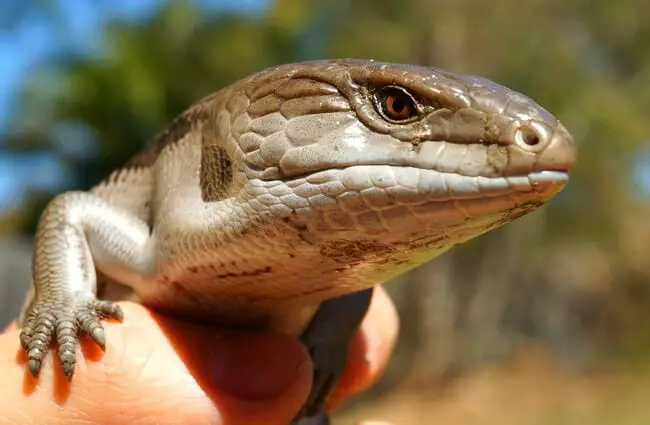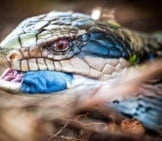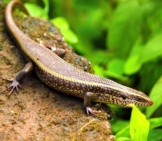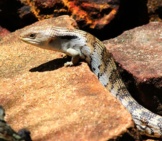Blue tongue skinks, also known as blue-tongued skinks, are an Australian genus of reptiles that are members of the skink (Scincidae) family. All blue tongue skinks are members of the genus Tiliqua, and are named for their characteristic blue tongues. There are eight different species in the genus, with various colors and patterns. Some species, the Australian blue-tongued skink in particular, are popular as pets. Read on to learn about the blue tongue skink.
Description of the Blue Tongue Skink
The easiest way to distinguish these creatures has to be their bright blue tongue, that is, if you can see it! When threatened by predators, they will display their tongues as an attempt to scare or intimidate. These reptiles are relatively large, and are some of the largest species in the skink family. Some species can be as long as 24 inches,including their tails.
Most species, save for the shingle back, have smooth,flat scales. The different species have a wide variety of patterns and color combinations, though most are sandy brown to dark brown in color.
Interesting Facts About the Blue Tongue Skink
These reptiles are commonly kept as pets, but there are actually a surprisingly large variety of blue tongue skinks. Learn more about the variety of species and their unique adaptations below.
- Eight Skink Species – The eight different members of the Tiliqua genus are as follows: Adelaide pygmy, Indonesian, Centralian, blotched, western, shingleback, Australian, and Irian Jaya. All the species are relatively similar in body shape and coloration, save for the shingleback, which has thick, ridged scales that resemble shingles on a roof.
- Clear the Sinuses – These creatures sneeze a lot! No, they don’t have a cold. They actually sneeze because their nasal passages become clogged with dirt or sand quite frequently. This is because they use their heads and noses to push and dig through the sand. If this sneezing is paired with discharge however, they could have an infection.
- Drop it – Like many other lizard and skink species, these creatures are capable of dropping their tails when a predator has captured them. Their tails continue to wiggle for an extended period, distracting the predator while the animal escapes. The skink can later regrow its tail.
- Crunchtime – These lizards have broad heads with strong jaws. They use those strong mouths to crunch through the shells of snails and tough insects. This helps them have a much wider diet than some other creatures.
Habitat of the Blue Tongue Skink
There are a number of different species, but they mostly utilize the same types of habitats. They will live in woodlands, grasslands, and agricultural areas, but also easily adapt to urban environments like parks and gardens.
Unlike some lizard species, these skinks are terrestrial, which means that they live on the ground rather than in the trees. Their thick bodies with short legs make them better adapted to burrowing and digging on the ground.
Distribution of the Blue Tongue Skink
The different species of blue tongue skinks have different ranges. The Adelaide pygmy species is found exclusively in a small portion of south Australia. The Indonesian, and Australian species are found in their respective namesakes, Indonesia and Australia.
The centralian species is found in New South Wales, Australia. The blotched blue-tongued skink is found in southeastern Australia, the western is found in western Australia, and the shingleback is located in Western Australia.
Diet of the Blue Tongue Skink
These reptiles are omnivorous, which means that they will feed on both plant and animal matter. All species are ground dwelling, and hunt amongst the lower vegetation and rocks during the day. They will prey on a wide variety of small invertebrates and creatures, including worms, snails, beetles, spiders, and various insects. They will also feed on fruits, flowers, and berries, if they come across them.
Blue Tongue Skink and Human Interaction
Because they are harmless, and live in areas that are not highly trafficked by humans, these reptiles do not interact with humans too frequently. Those that have adapted to urbanized living will have more common interactions, but are generally left to their own devices as they prey on pesky insects in gardens.
Capture for the pet trade has some impact on species, but they will reproduce readily in captivity, which decreases the pressure on wild specimens. Most species, save for the Adelaide pygmy, are considered to be Least Concern by the IUCN Red List.
Domestication
For an animal to undergo true domestication they must be selectively bred for extended periods of time. These reptiles are easily bred in captivity, but have not been formally domesticated in any way.
Does the Blue Tongue Skink Make a Good Pet
Yes, blue tongue skinks actually make very good pets. They can be quite docile and easy to care for, as long as the owner is properly educated to their needs. Always choose a pet that has been bred in captivity rather than captured from the wild.
Blue Tongue Skink Care
These reptiles should be housed separately from one another rather than in groups. Each needs a relatively large enclosure, no smaller than a 20-gallon aquarium. The top should be screened to prevent escapes, and keep your pet safe from other animals reaching it. They are not climbers, so surface area of the ground is more important than vertical climbing space.
Their enclosure must be kept at the optimal temperature designated by your breeder or veterinarian, and basking lamps should also be provided. They should be fed a wide variety of protein sources, fruits, and vegetables. Approximately half of their meal should be greens, a small amount of fruit, and the rest should be some type of protein.
Behavior of the Blue Tongue Skink
Blue-tongued skinks are solitary creatures that spend their days searching for food and basking in the sun. They are not very good climbers, as they have short legs and stout bodies. Rather than climb, these skinks will burrow into the sand and root around in search of prey. They also use burrows and crevices to escape from potential predators or hazardous weather.
Reproduction of the Blue Tongue Skink
The reproduction styles vary widely between species. All eight of the species are viviparous, which means that they give birth to live young, rather than laying eggs or developing eggs within their bodies. The number of young produced also varies. some species give birth to only a single or handful of offspring, like the Adelaide pygmy, while others can produce as many as 24 babies.
Beliefs, Superstitions, and Phobias About the Blue Tongue Skink
Old wives’ tales about blue tongue skinks are rampant, and all are untrue. The first rumor is that these reptiles are venomous. This likely came about because their brightly colored mouth can be very scary-looking when they are threatened!
In reality, the only venomous lizards are the gila monster and the Mexican beaded lizard. Another old tale purports that blue-tongued skink bites will reappear exactly one year after the bite occurred, this is also untrue.











![Red Angus Closeup of a beautiful Red Angus cowPhoto by: U.S. Department of Agriculture [pubic domain]https://creativecommons.org/licenses/by/2.0/](https://animals.net/wp-content/uploads/2020/03/Red-Angus-4-238x178.jpg)












![Red Angus Closeup of a beautiful Red Angus cowPhoto by: U.S. Department of Agriculture [pubic domain]https://creativecommons.org/licenses/by/2.0/](https://animals.net/wp-content/uploads/2020/03/Red-Angus-4-100x75.jpg)

